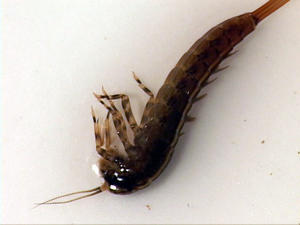
For the first part of this blog series, see Fly Fishing With Nymphs.1 - Clingers.
We continue our series of blogs on fly fishing with nymphs by discussing the swimming nymphs.
Swimmer nymphs hide in the cracks of rocks in the slow moving water of pools, pockets, and near the banks of the streams.
Swimmer nymphs actually swim through the water similar to minnows, making them somewhat of a challenge for the trout to catch. Instead of long distance swimming, these nymphs dart here and there, allowing them to quickly flee from trout. Their sleek shape facilitates their ability to swim about. Swimmer nymphs frequent areas near cover, such as rocks with numerous cracks, leaves, roots, logs, or cobble.
The legs of a swimming nymph do not come out from the nymph's sides, but rather from underneath the nymph. Their legs fold up when they swim. The gills of a swimmer nymph extend the entire length of their bodies.
Swimmers typically live in the same type of water (except they're usually in shallower water) that the crawlers enjoy. They need moving water to obtain enough oxygen, but they do not tolerate fast water. Ideal habitat for swimmer nymphs includes the edges and ends of pools, pockets next to the banks, shallow flats, shallow pockets behind boulders, shallow, slow moving riffles, and slow eddies, depending on the species. Note that the swimming nymphs can typically find numerous areas to avoid the direct current, even in fast water.
Generally, there are far fewer swimmer nymphs than clingers, though the trout tend to eat many more swimmers than clingers, but not as many as they eat of the crawler nymphs. Therefore, there will need to be a large number of swimmer nymphs in a stream to survive the predation by the trout. Basically, this breakdown comes down to how well the types of nymphs can hide from the trout. However, the trout tend to feast on whatever nymphs are within two weeks of the hatch, as those nymphs become more active (and consequently more exposed) during this time.
Common swimmer nymphs include the baetis species of blue winged olives and slate drakes. Often, you can see the blue winged olive nymphs in the water if you are very careful not to move. However, as soon as you make a movement, they will scurry to hide.
When fishing flies that imitate swimmer nymphs, use light, long leaders. Make long casts. You can fish them in a dead drift, but you can also twitch your line to cause short, darting motions. Fish them in the types of water described previously without much weight. During the pre-hatch and hatch time frames, flies that imitate swimmer nymphs will alow you to catch numbers of trout. The trout will often scoot into the shallower water to take the fly. Once again, you will need flies that specifically imitate these nymphs, such as the Perfect Fly brand flies, as the swimmers don't look like generic nymph flies. To further underscore this point, keep in mind that the swimmers are found in slower moving water, where the trout can inspect them fully.





